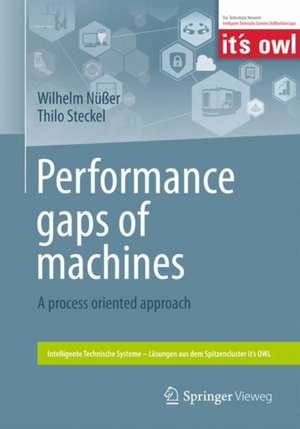Performance gaps of machines: A process oriented approach: Intelligente Technische Systeme – Lösungen aus dem Spitzencluster it’s OWL
Autor Wilhelm Nüßer, Thilo Steckelen Limba Engleză Paperback – 26 ian 2018
Although this situation is probably well known to many readers -- and very often not so quietly endured -- it was not studied systematically so far. This publication describes the conceptual background of the performance gap in a very general way. It develops a semi-quantitative description and points to approaches to reduce the performance gap in current and future environments.
Process executives, engineers and system analysts will hopefully benefit from this approach especially in the dynamic environments envisioned in initiatives like the German Industrie 4.0.
In the technology network Intelligent Technical Systems OstWestfalenLippe (short: it’s OWL) around 200 companies, universities, research institutions and organisations have joined forces to jointly shape the innovative leap from mechatronics to intelligent technical systems. Together they develop approaches and technologies for intelligent products and production processes, smart services and the working world of the future. The spectrum ranges from automation and drive solutions to machines, vehicles, automats and household appliances to networked production plants and platforms. This creates a unique technology platform that enables companies to increase the reliability, resource efficiency and user-friendliness of their products and production systems and tap the potential of digital transformation.
Preț: 377.18 lei
Nou
Puncte Express: 566
Preț estimativ în valută:
72.18€ • 77.18$ • 60.18£
72.18€ • 77.18$ • 60.18£
Carte tipărită la comandă
Livrare economică 17 aprilie-01 mai
Preluare comenzi: 021 569.72.76
Specificații
ISBN-13: 9783662564455
ISBN-10: 3662564459
Pagini: 87
Ilustrații: XV, 74 p. 24 illus., 12 illus. in color.
Dimensiuni: 168 x 240 mm
Greutate: 0.16 kg
Ediția:1st ed. 2018
Editura: Springer Berlin, Heidelberg
Colecția Springer Vieweg
Seria Intelligente Technische Systeme – Lösungen aus dem Spitzencluster it’s OWL
Locul publicării:Berlin, Heidelberg, Germany
ISBN-10: 3662564459
Pagini: 87
Ilustrații: XV, 74 p. 24 illus., 12 illus. in color.
Dimensiuni: 168 x 240 mm
Greutate: 0.16 kg
Ediția:1st ed. 2018
Editura: Springer Berlin, Heidelberg
Colecția Springer Vieweg
Seria Intelligente Technische Systeme – Lösungen aus dem Spitzencluster it’s OWL
Locul publicării:Berlin, Heidelberg, Germany
Cuprins
Introduction.- Concepts and Definitions.- Derivation and validation ot the gap formula.- Applications.- Conclusion.
Notă biografică
Prof. Dr. Wilhelm Nüßer studied physics at RWTH Aachen with a focus on theoretical and mathematical aspects. After several years at SAP he join the FHDW - University of Applied Sciences in Paderborn, Germany, as Heinz Nixdorf foundation professor. He authored many publications in national and international media and led several research projects. Since 2010 he is active in the leading edge cluster it's OWL.
Thilo Steckel studied agricultural sciences at Bonn University and specialized in process management. After 2 years working at a federal institute of soil sciences he joined CLAAS in 1994. CLAAS is a family owned manufacturer of mobile agricultural machines. He is currently working as senior project manager in the advanced engineering department of CLAAS E-Systems. Major research topics are data management and logistics.
Textul de pe ultima copertă
In this publication a widespread phenomenon is studied: in many usage scenarios modern complex machines show a significant difference between the maximum sustainable performance available in well specified environments and the average performance many users experience in their everyday interaction with the machine. This performance gap appears to be increasing with technical progress and performance of machines.
Although this situation is probably well known to many readers -- and very often not so quietly endured -- it was not studied systematically so far. This publication describes the conceptual background of the performance gap in a very general way. It develops a semi-quantitative description and points to approaches to reduce the performance gap in current and future environments.
Process executives, engineers and system analysts will hopefully benefit from this approach especially in the dynamic environments envisioned in initiatives like the German Industrie 4.0.
In the technology network Intelligent Technical Systems OstWestfalenLippe (short: it’s OWL) around 200 companies, universities, research institutions and organisations have joined forces to jointly shape the innovative leap from mechatronics to intelligent technical systems. Together they develop approaches and technologies for intelligent products and production processes, smart services and the working world of the future. The spectrum ranges from automation and drive solutions to machines, vehicles, automats and household appliances to networked production plants and platforms. This creates a unique technology platform that enables companies to increase the reliability, resource efficiency and user-friendliness of their products and production systems and tap the potential of digital transformation.
Although this situation is probably well known to many readers -- and very often not so quietly endured -- it was not studied systematically so far. This publication describes the conceptual background of the performance gap in a very general way. It develops a semi-quantitative description and points to approaches to reduce the performance gap in current and future environments.
Process executives, engineers and system analysts will hopefully benefit from this approach especially in the dynamic environments envisioned in initiatives like the German Industrie 4.0.
In the technology network Intelligent Technical Systems OstWestfalenLippe (short: it’s OWL) around 200 companies, universities, research institutions and organisations have joined forces to jointly shape the innovative leap from mechatronics to intelligent technical systems. Together they develop approaches and technologies for intelligent products and production processes, smart services and the working world of the future. The spectrum ranges from automation and drive solutions to machines, vehicles, automats and household appliances to networked production plants and platforms. This creates a unique technology platform that enables companies to increase the reliability, resource efficiency and user-friendliness of their products and production systems and tap the potential of digital transformation.
Caracteristici
Provides a novel and generally usable explanation of the empirically determined performance gap of complex machines Deepens the understanding of the requirements for product development Contains a clear classification for the optimization of processes and machines Complements the view of requirements for and ways to the fourth industrial revolution














